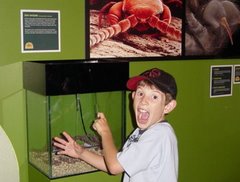This was a really cool session. Some points I noted for us to think about for our new site:
- Te Ara
caters to a traditional print-based audience as well as planning a play space for those who are more web-savvy - Found the blog didn't generate as much two-way engagement as they expected or wanted – reinforces the idea that you have to work hard to create and build community
- I liked their simple interface for uploading stories (although they haven't had much success with this in terms of people uploading stories)
- Our Space set up a Flickr group months ahead of launch to generate media interest and content (and build community too?)
- Integrated an online and physical experience, an exploration and playful space with little instruction, which is new for museums (but based on constructivist principles which are not new!)
- Originally user-generated content not part of the brief (same for Te Ara, we need to factor this in)
- 'Generation C' – content creators
- Focus groups with 15-24 year olds to help develop the brief. What did they find? Its' all about me now (therefore needs to be instantaneous); young people are digital content creators (they want control and choice and ability to share); they are used to making stuff digitally; curators really need to lose control (become moderators and facilitators); must also have something the web can't deliver (i.e. the exhibition space must be able to stand alone)
- Applied principles of social networking sites to a physical exhibition
- Provide visitor voice and platform to interact with the museum, losing their centralised structure and control – how to reconcile this with role of protecting national treasures? (I don't think they're mutually exclusive)
- Are working with Maori now to get their involvement as a separate project
- Institutional paradigm shift where hosts now encourage visitors to play and explore; think about viral distribution of information and bit more sense of collaboration within Te Papa now
A great session nicely summed up by Angelina who also ran the Q&A, which meant I didn't have to do anything!





